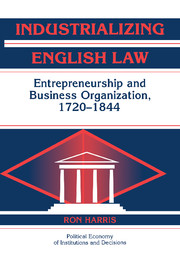Book contents
- Frontmatter
- Contents
- List of Tables
- Acknowledgements
- Introduction
- 1 The Legal Framework
- PART I BEFORE 1720
- PART II 1721–1810
- 4 Two Distinct Paths of Organizational Development: Transport and Insurance
- 5 The Joint-Stock Business Corporation
- 6 Trusts, Partnerships, and the Unincorporated Company
- 7 The Progress of the Joint-Stock Organization
- PART III 1800–1844
- Conclusion
- Appendix 1 The Rise and Decline of the Major Trading Corporations
- Appendix 2: Capital of Joint-Stock Companies Circa 1810
- Bibliography
- Index of Cases
- Index of Statutes
- General Index
7 - The Progress of the Joint-Stock Organization
Published online by Cambridge University Press: 12 August 2009
- Frontmatter
- Contents
- List of Tables
- Acknowledgements
- Introduction
- 1 The Legal Framework
- PART I BEFORE 1720
- PART II 1721–1810
- 4 Two Distinct Paths of Organizational Development: Transport and Insurance
- 5 The Joint-Stock Business Corporation
- 6 Trusts, Partnerships, and the Unincorporated Company
- 7 The Progress of the Joint-Stock Organization
- PART III 1800–1844
- Conclusion
- Appendix 1 The Rise and Decline of the Major Trading Corporations
- Appendix 2: Capital of Joint-Stock Companies Circa 1810
- Bibliography
- Index of Cases
- Index of Statutes
- General Index
Summary
In previous chapters, I surveyed the emergence of two models of business organization during the eighteenth century, the joint-stock business corporation and the unincorporated company. I demonstrated the entrepreneurs' preference for the corporation over the unincorporated company and showed the growing advantages of the corporation toward the end of the century, due to its personality, transferability, and liability features. In addition, I claimed that the unincorporated company could not, due to legal deficiencies, serve as a surrogate form of organization. But these three assertions taken together do not say much about the position of these forms of joint-stock organization in the economy as a whole. Was joint stock a marginal or a central phenomenon in eighteenth-century England? Did eighteenth-century joint-stock organizations have any significant impact on the contemporary economy, or is their study worthwhile only because they were precursors to the late nineteenth-century corporate economy? These questions were initially touched on in Chapter 4, which dealt with transportation and insurance, two significant sectors. The present chapter aims to broaden the perspective by dealing with the following questions: Was the development of the joint-stock undertaking during the eighteenth century confined to these two major sectors? Did other sectors pursue the paths of either transport or insurance, or did they follow other models of organization? What, if any, were the effects of the Bubble Act on the spread of the joint-stock form of association after 1720?
- Type
- Chapter
- Information
- Industrializing English LawEntrepreneurship and Business Organization, 1720–1844, pp. 168 - 198Publisher: Cambridge University PressPrint publication year: 2000



